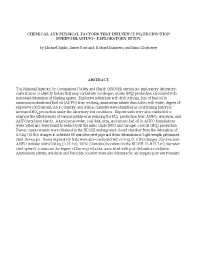Mining Publication: Chemical and Physical Factors that Influence N0x Production During Blasting: Exploratory Study
Original creation date: February 2002
Authors: MJ Sapko, JH Rowland, RJ Mainiero, IA Zlochower
NIOSHTIC2 Number: 20023402
Proceedings of the 28th Annual Conference on Explosives and Blasting Technique (Las Vegas, NV, Feb. 10-13, 2002). Vol. 2. Cleveland, OH: International Society of Explosives Engineers, 2002 Feb; :317-330
The National Institute, for Occupational Safety and Health (NIOSH) carried out exploratory laboratory scale studies to identify factors that may contribute to nitrogen oxides (NOx) production associated with non-ideal detonation of blasting agents. Explosive admixture with drill cuttings, loss of fuel oil in ammonium nitrate and fuel oil (ANFO) from wicking, ammonium nitrate dissolution with water, degree of explosive confinement, ANFO density, and critical diameter were identified as contributing factors to increased NOx production under the laboratory test conditions. Experiments were also conducted to examine the effectiveness of various additives in reducing the NOx production from ANFO, emulsion, and ANFO/emulsion blends. Aluminum powder, coal dust, urea, and excess fuel oil in ANFO formulations were tested and were found to reduce both the nitric oxide (NO) and nitrogen dioxide (NO2) production. Fumes measurements were obtained in the NIOSH underground closed chamber from the detonation of 4.5-kg (10 lbs) charges in schedule 80 seamless steel pipe and from detonations in light weight galvanized steel stove pipe. Some exploratory tests were also conducted with 0.8-kg (1.8 lbs) charges of pulverized ANFO initiated with 0.08-kg (0.18 lbs), 50/50 (pentolite) boosters (in the NIOSH 12-ft (3,7-m) diameter steel sphere) to measure the degree of fumes production associated with post-detonation oxidation. Ammonium nitrate, emulsion and Pentolite boosters were also detonated in an oxygen-poor environment.

NIOSHTIC2 Number: 20023402
Proceedings of the 28th Annual Conference on Explosives and Blasting Technique (Las Vegas, NV, Feb. 10-13, 2002). Vol. 2. Cleveland, OH: International Society of Explosives Engineers, 2002 Feb; :317-330